|
The Church is open on the first Saturday of each month 10:00 am until 12 noon. Come in for a look around, coffee, biscuits, cakes for sale. |
SAINT MARY THE VIRGIN
RADWINTER
by
The Rev'd. Cecil Gore Brigley M.A. Rector 1936 - 1944
as amended by The Rev'd. Frank Harwood M.A.
The Friends of Radwinter Church 1993
with corrections and additions by Mr Julian Litten of the Victoria
and Albert Museum, and a Patron of the Friends
and by The Rev Brian Macdonald-Milne.
Edited last 2004.
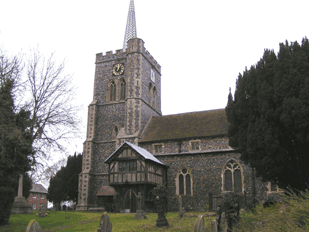
"I was glad when they said unto me
we will go into the House of the Lord"
Psalm 122, verse
The Parish Church of Saint Mary the Virgin, Radwinter stands in the centre of the village and has stood for some 700 years. It is built of flint and white limestone with bands of tiles of irregular length and spacing. The roofs are covered with tiles and lead.
The oldest part of the Church is the Nave - as far as to the last pair of arches towards the East.
On the second and third arches of the North Arcade, remains of mediaeval painted decorations in red and yellow bands could still be seen until the 1960's when sadly, despite the then architect William Eden Nesfield's advice in 1868, they were painted over. A West tower was built in c. 1350 and rebuilt with the spire by Mr Temple Moore in 1887-8, after he had taken over from Nesfield as the Church's architect.
The restoration and enlargement of the Church was undertaken by the Reverend John Frederick Watkinson Bullock (Rector from 1865-1916) on his own initiative, and largely at his own expense, though he did appeal for co-operation from members of the Vestry before he set to work. Nesfield was the Architect. Letters of his describing his work are still remaining and have been published by the Friends of Radwinter Church under the title "A Deuce of an Uproar". The Chancel was rebuilt and lengthened to its present proportions; the south and north aisles were rebuilt. The clerestory was remade using old materials. Quaint stone heads, of medieval age, can be seen below the five roof beams. A north vestry and a south vestry and an organ chamber were added. The church was re-consecrated by the Bishop of Rochester (in whose diocese Radwinter then was) on Wednesday 25th May 1870.
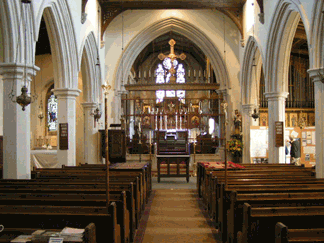
The columns of the north of the nave are octagonal in shape with moulded capitals and modern bases.
The north aisle was added to the Church in 1340 and has in its east wall a reset fourteenth century window showing painted glass of St. Alban and St. Etheldreda of Ely. This window formerly contained the coat of arms of the Bendysh family.
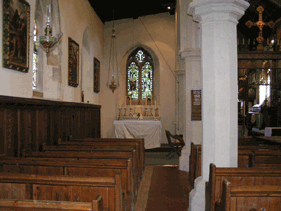
There is an altar below this window on which stands a tabernacle containing the Blessed Sacrament of the Body and Blood of Christ. A veil hangs over the tabernacle and a white light burns in the lamp hanging before this altar to indicate that the Most Holy is present and to be adored. A fourteenth century piscina has been reset in the wall to the right of this altar.
The banner of our Lady and the Holy Child stands on the left of this altar. It was given to the Mothers' Union branch by subscription in 1956 for a memorial to Violet Dorothy Cowell, Lucy Halls, Sarah Baynes and other departed members.
The door in the wall of the north aisle is of the fourteenth century and now leads into the modern vestry.
The tower arch at the back of the church is fourteenth century work reset. The West window is nineteenth century but has some fourteenth century stonework. The painted glass in it shows incidents which have to do with the birth and childhood of Our Lord. The light which shows Him at the age of 12 in the Temple, gives the features of Mr. Gladstone, Lord Salisbury and Sir William Vernon Harcourt to the "doctors" who are speaking with Him.
The Flints facing the walls and tower are the work of an old family who lived at Brandon and had been flint knappers for many centuries. In the middle of each outer wall of the bell chamber, below the parapet, a sixteenth century gargoyle is reset.
There are eight bells in the tower, and the fourth and seventh are by Robert Oldfield, dated 1616. The fifth is of 1629 by Robert Oldfield. The sixth is probably by Roger Reve in the sixteenth century and is inscribed with the words "Santa Maria, ora pro nobis", which means, "Holy Mary, pray for us". The smallest bell was given by the children of Radwinter at the restoration. One of the bells came originally from Wimbish church when there was a tower there.
The Blessing of the church bells took place at 7.30 a.m. on 25th May 1888. One who was present wrote: "Johnny Swan and Willie K. (in their red cassocks etc.) carried a brass pail of holy water and a brush, behind the Choir and before Fred (the Rector), who was acting as deputy for the Bishop. Minnie Emson, Janet Gowlett and Lucy Lilley followed, and we progressed up the tower, we females remaining in the doorway on the stairs. A very nice little service was then proceeded with - Fred sprinkled all the bells except the pre-Reformation one. We then scrambled down in front of them and proceeded to the Celebration of Holy Communion in Church, which was choral - music Helmore".
There is a small bell in a turret on the north side of the Chancel roof, intended for ringing at the moment of consecration in the Eucharist. Those outside the Church are reminded by this of what is taking place inside.
The roof of the nave is of four bays with two fourteenth century king-post trusses. The flat lean-to roof on the North Aisle is largely nineteenth century but most of the middle purlieu, upper wall-plate and embattled lower wall-plate are of the sixteenth century.
The roof of the South Aisle is similar to that of the North Aisle, but the alternate principals have curved brackets at the lower ends and one wall-piece terminates in a grotesque head.
The eight large pictures of the stations of the cross which hang around the nave begin at the east end of the north aisle and illustrate Our Lord condemned to death by Pilate, carrying the Cross, crucified, dead and buried. They are probably of German workmanship. There were originally fourteen.
The triptych, now kept in the chancel, which was formerly below the fifth station of the cross, may be Italian, perhaps Sienese and gives a demi-figure of Our Lady Saint Mary and the Holy Child and two Saints on the wings who may be Saint Louis and Saint Clare.
The windows in the north wall picture Old Testament events in which angels are active in the top lights, and corresponding incidents from the New Testament in the lower lights.
The window at the west end of the north aisle illustrate the Sacrament of Holy Baptism, with pictures of the Flood and of the crossing of the Red Sea above.
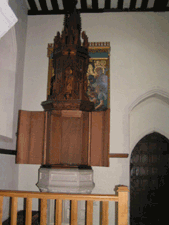
The font stands on steps at the west end of the north aisle and was set up at the restoration with a richly carved wood towering canopy. A statue of the Blessed Virgin Mary and the Holy Child Jesus is on the top of the canopy - and carvings representing angels and prophets are below. Doors in the back give access to the water in the stone font. The font was given in memory of William Clayden, who died in 1877, by his sister Emma. It was dedicated on the first Sunday in Advent, 1879.
The wooden platform and railing round the font, was added in 1996 to give safer access to the font.
The large picture of Christ with the children, hanging on the north wall beside the font was given by the architect, William Eden Nesfield.
An aumbry (that is a cupboard) is in the wall to the south of the font, and was restored in 1937. It is covered with a purple curtain and contains the Holy Oils used in the Sacraments of Holy Baptism, Confirmation and Holy Unction.
The columns on the south of the nave are much restored and re-cut. They have clustered shafts with moulded capitals and nineteenth century bases.
The south aisle was added to the nave in about A.D. 1280. The altar now standing at the east end of this aisle was given, with its ornaments, in the present century. This has been used for some years as a children's altar and the altar cloth was presented by Mrs Kitt Rowley in memory of her infant grandson and produced by Mrs Carol Macdonald from designs contributed by the children of Radwinter and others.
The richly ornamented paintings behind this altar were given to commemorate the 48th anniversary of the ordination of the Reverend J F W Bullock. Reading from left to right, are shown:
|
|
Angels holding the coat of arms of the Diocese of St. Albans |
|
|
Jubal |
|
|
Saint Cecilia |
|
|
Saint Gregory the Great |
|
|
Miriam, the sister of Moses |
|
|
Angels supporting the coat of arms of the Bullock family. |
The windows in the south wall are by Howard & Gibbs and illustrate miracles and parables of Our Lord Jesus Christ, and also the fall and restoration of humanity.
The window at the west end of the south aisle, also by Howard & Gibbs, illustrates the sacrament of the Holy Communion in the lower lights, with pictures of the manna in the wilderness and spies returning from the promised land with clusters of grapes above.
The south porch was added in about 1350 and also the door. The room above this porch was rebuilt at the restoration and is now used as a muniments room. There had been a room before but it was derelict by 1800. The access stairs are from drawings produced by the current Architect, Mrs Kay Pilsbury from sketches left by Mr William Eden Nesfield (reproduced in the Church Friends' publication, A Deuce of an Uproar). Both the stairs and the font rails are the work of the local craftsmen, Reynolds Joinery and were consecrated by the Bishop of Colchester in 1997.
The small nineteenth century holy water bowl stands on an old stone ledge inside the south door.
The oil lamps for lighting the nave and aisles, provided by subscription at the turn of the nineteenth century, were retained in position when electric lighting was installed for the whole church in 1950, under the direction of the architect Mr Stephen Dykes Bower.
The original small chancel of the Church had been rebuilt in about 1325. The present chancel is entirely nineteenth century except for the chancel arch which dates from 1300 and has now been reset one bay to the east of its original position.
The chancel screen of metal with scroll work was made after 1880 by a whitesmith named Martin of Saffron Walden.
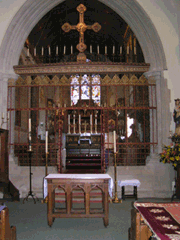
The beam above the screen carries the words St. Peter wrote in his first epistle (ch.2, v.24): "Peccata Nostra Pertulit In Corpore suo Super Lignum", which means, "Who His own self bore our sins in His own body on the tree". That tells us that Christ died on the cross made from a tree "to pay the price of sin" - our sins. The crucifix above the beam is of Italian design and carries at the ends of the cross the emblems of the four evangelists - St. Matthew, St. Mark, St. Luke and St. John.
The style of the beam with its crucifix and fourteen candles is reminiscent of that to be seen in Milan Cathedral. In 1959 fourteen electric candles were substituted, through the generosity of the late E E Gardiner.
The statue of the Blessed Virgin Mary and the holy child Jesus stands to the south of the screen and is of French design. It is a memorial to the Reverend G C Brigley, Rector from 1936 to 1944. Two fine brass candle stands containing fifteen candles each, have at present come to rest on either side of this statue. They were formerly for lighting the High Altar. A statue of Our Lord was offered to the Church in memory of Carol Major in 1959. The tapestry picture of the Blessed Virgin Mary was made by Mrs Hilda Cass, a member of the congregation.
The pulpit, which now stands to the north of the screen, was given in 1892 by Daniel Kent Emson, for many years Rector's Warden.
The roof painting of the chancel shows the crowned monogram of the Blessed Virgin Mary and the monogram of Saint Alban, as Radwinter was from 1877 to 1913 in St. Albans Diocese.
The chief feature of the church, as of every church, is the high altar. At this altar, as at every Christian altar, the Christian Sacrament of the presence of Christ is offered in the Eucharist (sometimes called the Mass, Holy Communion, or the Breaking of Bread). The table top of the altar is a stone slab eight and one third feet by two and a half feet. The front of the altar is of painted wood showing six angels. There are eight frontals of the various colours used in church. They are mostly over ninety years old, though the green one, skilfully reconditioned by the Reverend J M Rolleston (Rector 1944 to 1949) may be from material used in Westminster Abbey at the coronation of King Edward VII.
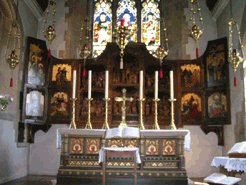
Above and behind the high altar is the magnificent wooden Reredos of Flemish workmanship of the early sixteenth century. It was bought for Radwinter church from a saleroom in London in 1888. It contains six scenes from the life of Our Lady, with small free-standing figures against shallow carved backgrounds, with elaborate tracery. An illustrated booklet on the reredos was published by the Friends of Radwinter Church in 2003.
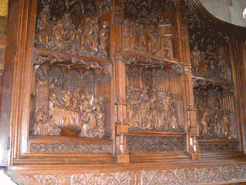
The top middle recess shows the Blessed Virgin as a little girl being presented in the temple. The lower middle recess shows her being espoused to St. Joseph; the top left and right hand recesses show the arrival of the Wise Men and the Shepherds, respectively, at Bethlehem. The bottom left recess gives the scene at her death bed and the bottom right recess is her funeral procession.
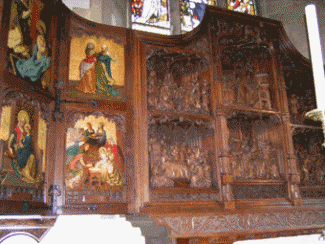
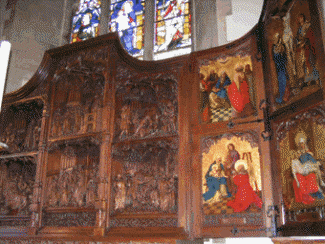
The two side wings of the Reredos are additionally designed by Mr Temple Moore. On the left wing is to be seen the birth and childhood of the Blessed Virgin, and above, her Annunciation and Visitation. On the right wing Our Lady is shown standing beside the cross on Good Friday; with the body of Her Divine Son in her arms after He had been taken down from the cross; Mary with the Apostles on the first Whitsunday; and finally St. Luke painting her portrait with the Infant Jesus on her knee. Further details are given in the illustrated booklet.
The two large pictures in the chancel are copies of pictures in the Vatican, of the Transfiguration of Our Lord, by Rafael, and of the Last Communion of St. Jerome.
The glass in the east window behind the high altar is in three lights and shows Our Lady and the Holy Child, the Patriarch Abraham and King David. It was given in 1870 as a memorial by two members of the Bullock family. There are fragments of medieval glass in the chancel and north vestry windows. A roundel, depicting a cherub, is on the south window to the chancel. It is of early twentieth century local workmanship.
The chair within the altar rails is of seventeenth century workmanship with nineteenth century work in the back.
There are three chests in the nave, a small hutch type and two large panelled ones, of the sixteenth and seventeenth century respectively, all at the back of the church.
There are Sedalia on the south side of the sanctuary; that is stone seats for the Priest, Deacon and Subdeacon at High Mass.
The processional cross is 300 years old and is of Spanish workmanship. The processional torches harmonise with the processional cross and are in memory of the late William Underwood.
The organ is by Miller of Cambridge, three-manual with pedal movement. The organ, carved casing and choir stalls are of late nineteenth century. The "opening of the new organ" took place on Sunday and Monday 26th and 27th May 1872. It was restored in 1994-5 with part of a legacy from Mr Charles Hutchings, one time Assistant Organist and chorister.
The seven richly chased lamps with ruby glasses have hung before the high altar since the 1890s. Such lamps indicate a holy place. The two brass standards with cavelles, on the step before the altar, are copies of two such in Southwell Minster. The hanging candelabra in the chancel and the church are Dutch work of 200 years ago. Lighted candles speak of Christ, the Light of the World, and of His burning love for us.
The Church plate includes a silver gilt Dutch chalice, bearing the date 1541, which originally belonged to the parish church of Driel in Gelderland, Holland. and a silver gilt chalice of Spanish workmanship, also of the sixteenth century; and a French made paten embossed below with a picture of St. Francis of Assisi. These along with a ciborium, two censers, holy water vat, mother of pearl Baptism shell, cruets and other plate are of the nineteenth century or later. But the large magnificent Nuremberg alms dish is of considerable age. The former church plate was disposed of, though pictures of it can be seen in records of Essex Church plate of the nineteenth century at one time in use. The fine Altar Book, formerly used at the high altar, was given in 1953 in memory of two parishioners. An unusual pyx, probably of seventeenth century workmanship, is used for the Blessed Sacrament at some services.
An unusually beautiful Illuminated Altar Service Book bound in red velvet with silver mounts, 1867, is believed to have been presented to the church by the Rector on the completion of the first stage of the restoration and enlargement.
The Church also possesses a beautiful velvet pall of nineteenth century workmanship, to cover a coffin in Church when desired.
Former Parsonages
Until the second World War, when it was requisitioned by the Ministry of Defence, the Rectory was the house known today as "Radwinter Manor" and now divided into separate privately owned dwellings. It was built in 1810 in the grounds of the timber-framed Parsonage (shown on a Glebe map of 1752) which it replaced.
A Terrier (an inventory) of 1610 records two other "mansions" held by the Church, both South of the churchyard, one called "The Great Vicarage" and the other "The Less". Both still survive in private ownership. "The Less", which has been known for many years as "The Old Vicarage" was used as the Rectory for some years until the present Rectory was built in 1958.
Information Request.
If you would like information about or from The Friends of Radwinter
Church